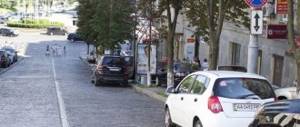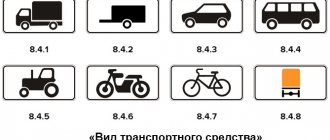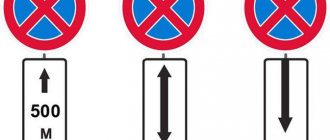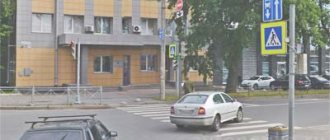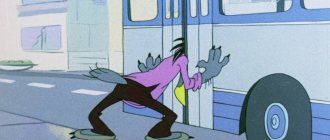Text of the Russian Traffic Regulations:
12.4. Stopping is prohibited:
- on tram tracks, as well as in the immediate vicinity of them, if this creates interference with the movement of trams;
- at railway crossings, in tunnels, as well as on overpasses, bridges, overpasses (if there are less than three lanes for traffic in a given direction) and under them;
- in places where the distance between a solid marking line (except indicating the edge of the roadway), a dividing strip or the opposite edge of the roadway and a stopped vehicle is less than 3 m;
- at pedestrian crossings and closer than 5 m in front of them;
- on the roadway near dangerous turns and convex breaks in the longitudinal profile of the road when the visibility of the road is less than 100 m in at least one direction;
- at the intersection of roadways and closer than 5 m from the edge of the roadway being crossed, with the exception of the side opposite the side passage of three-way intersections (crossroads) that have a continuous marking line or dividing strip;
- closer than 15 meters from the stopping places of fixed-route vehicles or parking for passenger taxis, indicated by marking 1.17, and in its absence - from the sign of the stopping place of fixed-route vehicles or parking for passenger taxis (except for stops for boarding and disembarking passengers, if this does not interfere with the movement of fixed-route vehicles vehicles or vehicles used as passenger taxis);
- in places where the vehicle will block traffic lights, road signs from other drivers, or make it impossible for other vehicles to move (enter or leave), or interfere with the movement of pedestrians.
- in the bike lane.
Let's take a closer look at the places where stopping is prohibited:
Stopping on overpasses, bridges, overpasses and under them is prohibited
This ban immediately provides an exception if stopping is allowed in a given direction for more than three lanes. The exception applies only when located on these objects. Stopping under overpasses and overpasses is prohibited.
As in previous cases, the traffic rules do not clearly define the boundaries of these road structures. They may be determined differently in each case by each inspector and each judge. Some along the sign with the name of the river, some along the fences of bridges, some at the beginning of the ascent, and so on.
Stopping is prohibited if the interval is less than 3m to the opposite edge of the roadway
In this case, it should be noted that the tram tracks located in the middle, according to the definition of the Rules, are also one of the edges of the roadway
The traffic rules miss the point that two cars can park in one place at the same time, and at the same time there will be a very narrow passage, but this will not be considered a violation if the possibility of passage remains.
Amount of fine
If, however, the driver made an illegal stop in the wrong place, he will have to pay a fine. As of 2018, the amount of damage for a motorist will be 500 rubles. If a case of violation is recorded in Moscow or St. Petersburg, the amount of 2,500 rubles increased fivefold will have to be paid to the state treasury.
Fines may be higher if the vehicle is stopped in the following places:
- At public transport stops. The fine will be 1,000 rubles, for Moscow and St. Petersburg - 3,000 rubles.
- At pedestrian crossings. Traffic regulations prohibit stopping vehicles closer than 5 meters to crossings. The amounts for violation are the same as indicated in the paragraph above, that is, 1,000 and 3,000 rubles, respectively.
- In parking spaces for the disabled. Wrongfully stopping traffic under a sign will result in a payment of 5,000 rubles. The car itself can be moved to a specialized site.
- On the tram tracks. Interference with public transport will cost 1,500 rubles, for residents of capitals - 3,000 rubles.
- On the roadway. Stopping traffic in general vehicle traffic areas without a valid reason may result in a fine of 2,000 rubles, or up to 3,000 rubles in Moscow and St. Petersburg.
In some cases, given the increased degree of danger of the situation, a more severe punishment may follow. Thus, stopping a car on railway tracks often leads to the deprivation of a driver’s license for a period of 3 months to 1 year.
It is prohibited to stop at pedestrian crossings and within 5 m in front of them
Since stopping is also allowed on the left oncoming side of the road, a situation arises that it would seem possible to stop on the left side after passing a pedestrian crossing. This interpretation is not correct. “Before the crosswalk” should be interpreted relative to the intended direction of travel in the lane, not the actual direction of the vehicle. This is both logical and safe.
It is prohibited to stop at the intersection of roadways and closer than 5 m from the edge of the crossed roadway
Another case of the inability to unambiguously determine boundaries. Crossing roadways is not defined in the traffic rules. It is customary to determine boundaries along imaginary lines of continuation of the boundaries of each of the roadways. However, the technical curves of roadways also belong to the intersection and are intended for the movement of vehicles; accordingly, they are also a roadway and are included in the area of intersection of roadways. The line of the crossed roadway remains straight.
The exception is intersections at T-shaped intersections provided that there is a continuous marking line or dividing strip
Fine for violating stopping or parking rules in 2021
01.01.2020
As you remember from the traffic rules, parking is prohibited: on tram tracks, as well as in the immediate vicinity of them, if this will interfere with the movement of trams, at railway crossings, in tunnels, as well as on overpasses, bridges, overpasses (if for traffic in this direction there are less than three lanes) and below them, in places where the distance between the solid marking line (except for the edge of the roadway), the dividing strip or the opposite edge of the roadway and a stopped vehicle is less than 3 m, at pedestrian crossings and closer than 5 m in front them, on the roadway near dangerous turns and convex breaks in the longitudinal profile of the road when the visibility of the road is less than 100 m in at least one direction, at the intersection of roadways and closer than 5 m from the edge of the crossed roadway, with the exception of the side opposite the side passage of three-way intersections (intersections) ), having a continuous marking line or dividing strip, closer than 15 meters from the stopping places of route vehicles, indicated by marking 1.17, and in its absence - from the indicator of the stopping place of route vehicles (except for stopping for boarding or disembarking passengers, if this does not create interference movement of route vehicles), in places where the vehicle will block traffic lights, road signs from other drivers, or make it impossible for other vehicles to move (enter or leave), or interfere with the movement of pedestrians.
Parking is prohibited: in places where stopping is prohibited, outside populated areas on the roadway marked with sign 2.1, closer than 50 m from railway crossings.
Text of Article 12.19 of the Administrative Code.
Article 12.19 Violation of the rules of stopping or parking vehicles.
1. Violation of the rules for stopping or parking vehicles, except for the cases provided for in Part 1 of Article 12.10 of this Code and Parts 2 - 6 of this Article.
A warning or a fine of 500 rubles.
Fine for illegal parking – part 1 of article 12.19 of the Code of Administrative Offenses
2. Violation of the rules for stopping or parking vehicles in places designated for stopping or parking vehicles of disabled people.
A fine for the driver in the amount of 5,000 rubles.
Fine for parking in a space for a disabled person - Part 2 of Article 12.19 of the Code of Administrative Offenses
3. Stopping or parking of vehicles at a pedestrian crossing and closer than 5 meters in front of it, with the exception of a forced stop and the case provided for in Part 6 of this article, or violation of the rules for stopping or parking vehicles on the sidewalk, except for the case provided for in Part 6 of this article .
A fine of 1000 rubles.
Fine for parking in front of a pedestrian crossing - Part 3 of Article 12.19 of the Administrative Code
3.1. Stopping or parking of vehicles at stops for route vehicles or parking for passenger taxis, or closer than 15 meters from stopping places for route vehicles or parking for passenger taxis, with the exception of stopping to pick up or disembark passengers, forced stops and cases provided for in parts 4 and 6 of this articles.
A fine of 1000 rubles.
- Fine for stopping at a bus stop - Part 3.1 of Article 12.19 of the Code of Administrative Offenses
- Stopping and parking at a bus stop (all on the shelves)
3.2. Stopping or parking vehicles on tram tracks or stopping or parking vehicles further than the first row from the edge of the roadway, with the exception of a forced stop and the cases provided for in parts 4 and 6 of this article.
A fine of 1,500 rubles.
Fine for parking in the second row - Part 3.2 of Art. 12.19 Code of Administrative Offenses
Parking on the square - Part 3.2 of Art. 12.19 Code of Administrative Offenses
4. Violation of the rules for stopping or parking vehicles on the roadway, resulting in the creation of obstacles to the movement of other vehicles, as well as stopping or parking a vehicle in a tunnel, except for the case provided for in Part 6 of this article.
A fine of 2000 rubles.
Fine for parking that creates interference – Part 4 of Art. 12.19 Code of Administrative Offenses
5. The violation provided for in Part 1 of this article, committed in the federal city of Moscow or St. Petersburg.
A fine of 2500 rubles.
6. Violations provided for in parts 3 - 4 of this article, committed in the federal city of Moscow or St. Petersburg.
A fine of 3,000 rubles.
Return to the section Fines under articles of the Code of Administrative Offenses for violating traffic rules
Car evacuation in questions and answers
Traffic rules - Stopping and parking
Parking in winter on the even and odd sides of the road
Fine for failure to comply with road signs
It is prohibited to stop at places where route vehicles stop.
If the stopping place is marked with marking 1.17, stopping is prohibited within 15 meters before and after the marking.
If the stopping place is marked with a sign 5.17 or 5.18, then the prohibited zone is located at a distance of 15 meters before and after the sign.
The exception is a stop for boarding or disembarking passengers, in which case there should be no interference with route vehicles or passenger taxis
If the stopping place is not marked with a sign and/or markings, stopping is permitted.
It is not prohibited to stop on the opposite side of the road opposite the stopping place, even if the road width is less than 15 meters.
Rules for stopping and parking vehicles
12.1 Vehicles are allowed to stop on the side of the road on the right side of the road lanes or on the edge of the roadway if the road design does not provide a shoulder. If the situation fits into case 12.2, then parking and stopping on the sidewalk are permitted .
If there is a shoulder, stopping not on this section, but on the edge of the roadway will be considered a traffic violation. Parking on the left side of the road is permitted only when the roadway is in a populated area on a road with only one lane for both directions or when there is one-way traffic on it . In this case, signs 5.23.1 or 5.23.2 must be present, and there must be no continuous markings or tram tracks. Permitted only on two-lane roads. On a three-lane road, stopping on the left side is prohibited.
12.2 It is permissible to place the vehicle parallel to the edge of the roadway in one row, and if the vehicle has two wheels, then it is permissible to use two rows . To determine the method of installing the vehicle in the parking lot, use a special sign 6.4 plus plate 8.6.1 - 8.6.9. Additionally, appropriate markings may be present.
On the edge of the sidewalk, the border of which is located next to the roadway, only bicycles, mopeds, motorcycles, and cars can stand. This rule applies if there is sign 6.4 and a plate from the list:
- 8.4.7;
- 8.6.2;
- 8.6.3;
- 8.6.6 — 8.6.9.
Information signs when stopping and parking a vehicle.
Permission to stop does not apply to trucks. The absence of sign 6.4 automatically removes all permissions specified in this paragraph.
12.3 For overnight stops or rest outside the populated area, special areas are provided that are located within the coverage area of signs 6.4 and 7.11.
12.4 In what places is stopping prohibited:
- on the territory of railway crossings, on bridges, overpasses, overpasses if there are less than three lanes for traffic in one direction, under the specified objects;
- in the area of tram tracks, both on the rails themselves and nearby, if this interferes with the normal operation of the tram;
- in those places where the free distance between the dividing solid marking line, the opposite edge of the roadway or dividing strip and the vehicle that made the stop remains less than three meters;
- within a radius of 5 meters near pedestrian crossings, as well as at the crossings themselves;
- on a bike path;
- at the intersection of roadways, as well as closer than 5 meters from the edge of the roadway being crossed, minus the side opposite the side passage of intersections on three sides that have a dividing strip or a continuous marking line;
- in the area of the carriageway of the roadway next to dangerous turns, convex breaks in the longitudinal profile of the road, if visibility on it in at least one direction is less than 100 m;
- in places where the location of a stopped vehicle will block drivers’ view of traffic lights, road signs, or will impede or prevent the access of other vehicles or block the passage of pedestrians;
- less than 15 m from the parking of route vehicles or the parking area of a passenger taxi. The exception is the boarding or disembarking of passengers, provided that the process does not interfere with other traffic participants.
12.5 Parking is prohibited where stopping and parking is openly prohibited, within a radius of 50 m from railway crossings, as well as outside populated areas on the roadway marked with sign 2.1 . If only parking is prohibited, then stopping for a short time is permitted.
12.6 Forced stopping of vehicles where stopping of transport is prohibited , the driver must take all measures to ensure that his car is removed from the prohibited area.
12.7 Opening doors is prohibited if this may interfere with other traffic participants.
12.8 You can leave the vehicle after stopping when the driver is convinced that there will be no spontaneous movement of the vehicle or an attempt to use the vehicle in the absence of the driver.
